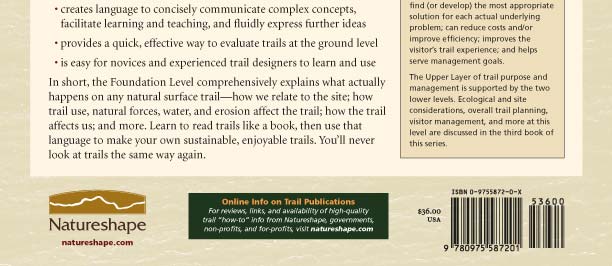 |
||||
 |
Natural Surface Trails by Design: Physical and Human Essentials of Sustainable, Enjoyable Trails Troy Scott Parker Full book description | Workshops based on this book |
| Browse sample pages: Front cover | Back cover | Table of Contents, 1st page | Table of Contents, 2nd page | Switchbacks (p. 32) Displacement (p. 37) | Compaction & displacement (p. 38) | Tread wear by modality (p. 41) | Tread soil test (p. 50) Trail Evaluation form (p. 64) | Sample trail evaluation (p. 69) |
 |
||
 |
||
 |
||
 |
| Back cover text:
You can use one system of thought to generate any sustainable, naturalistic, and enjoyable trail on Earth |
|
| enables anyone to think like an experienced trail designer—to see and use the underlying human and physical factors that advanced trail designers use to make decisions | |
| crystalizes the basic forces and relationships—both physical and human—of natural surface trails in a manageable, logical system of causes and consequences | |
| creates a flexible system of thought that helps generate appropriate solutions for any context; that works with new situations, materials, and techniques; and that tells you if something won’t work | |
| focuses on the “whys” of situations instead of just “how” or “what” | |
| relates dozens of trail aspects that previously seemed separate—or weren’t even apparent to you | |
| predicts future changes and accounts for trails changing shape over time, especially changes caused by trail use and erosion | |
| weaves trails into their sites; uses natural features to improve sustainability and visitor enjoyment; and helps engender respect, appreciation, and stewardship for trails and natural resources | |
| creates language to concisely communicate complex concepts, facilitate learning and teaching, and fluidly express further ideas | |
| provides a quick, effective way to evaluate trails at the ground level | |
| is easy for novices and experienced trail designers to learn and use | |
| In short, the Foundation Level comprehensively explains what actually happens on any natural surface trail—how we relate to the site; how trail use, natural forces, water, and erosion affect the trail; how the trail affects us; and more. Learn to read trails like a book, then use that language to make your own sustainable, enjoyable trails. You’ll never look at trails the same way again. A Three-Level Structure for Trail Design, Construction, Maintenance, and Management The Trails by Design Series establishes a three-level structure for the full picture of natural surface trails. The Foundation Level, described at left and in this book, explains how basic human and physical forces and relationships act and interact where the trail touches the ground. At the Middle Level, trail design, construction, and maintenance techniques are based on the Foundation Level. Described in the second book of this series, this level improves trail design, construction, and maintenance techniques; helps us find (or develop) the most appropriate solution for each actual underlying problem; can reduce costs and/or improve efficiency; improves the visitor’s trail experience; and helps serve management goals. The Upper Layer of trail purpose and management is supported by the two lower levels. Ecological and site considerations, overall trail planning, visitor management, and more at this level are discussed in the third book of this series. |
|
Home | Thinking Like a Trail Designer | Trail Books | Education & Training | Consulting | Contact Us |